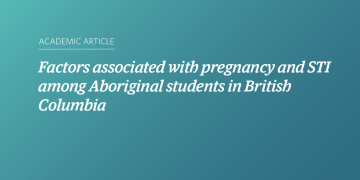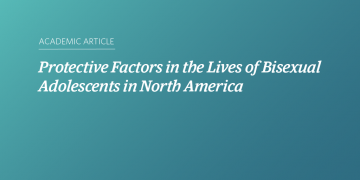Our right to choose: Religious conservatives versus LGBTQ-inclusive schools
The “gay agenda” is a rhetorical strategy deployed by the religious right and other social conservatives to magnify fear and hostility of queers. Queers are accused, among other things, of strategizing to recruit children into sexually deviant lifestyles; dismantling family and marriage as cornerstones of civilization; and forcing the entertainment industry and court systems to […]
Sexual-orientation disparities in substance use in emerging adults: A function of stress and attachment paradigms
Abstract More lesbian, gay, and bisexual (LGB) youths than heterosexuals report substance use. We examined a theoretical model to understand these disparities in lifetime and past-year substance use by means of stress and attachment paradigms, using the longitudinal Growing Up Today Study (GUTS) and Nurses’ Health Study II (NHSII). GUTS participants are the children of […]
From Hastings Street to Haida Gwaii: Provincial results of the 2013 BC Adolescent Health Survey
The 2013 BC Adolescent Health Survey was administered to almost 30,000 public school students across the province. It provides a comprehensive look at the health of youth aged 12–19. This is the fifth time students have been asked to complete the survey since 1992, and the regional coverage was the highest yet. Fifty-six of the […]
Substance Use and Sexual Orientation among East and Southeast Asian Adolescents in Canada
Abstract The purpose of this study was to examine the relationship between substance use and sexual orientation among Asian adolescents in Canada. We analyzed an East- and Southeast-Asian subsample of a province-wide, school-based survey (weighted N = 51,349). Compared to heterosexual adolescents of the same gender, gay, lesbian, bisexual, and mostly heterosexual adolescents were more likely to use […]
Research on Adolescent Sexual Orientation: Development, Health Disparities, Stigma, and Resilience
Abstract The decade between 1998 and 2008 saw rapid increases in research on adolescent sexual orientation development and related health issues, both in the quantity and in the quality of studies. While much of the research originated in North America, studies from other countries also contributed to emerging understanding of developmental trajectories and social influences […]
Restoring Healthy Developmental Trajectories for Sexually Exploited Young Runaway Girls: Fostering Protective Factors and Reducing Risk Behaviors
Abstract Purpose: To examine effects of the Runaway Intervention Program (RIP), a strengths-based home visiting, case management, and group support program for sexually assaulted or exploited young runaway girls; staffed by advanced-practice nurses, RIP aims to restore healthy developmental trajectories by reestablishing protective factors, reducing trauma responses, and lowering risk behaviors that are common sequelae of sexual violence. Methods: Quasi-experimental study of […]
Best Practices for Asking Questions about Sexual Orientation on Surveys
In 2003 the Ford Foundation began funding a multi-year project that sought to increase the quantity and quality of data on gay, lesbian, and bisexual people, and, by extension, on heterosexual people. Over a five-year period, many researchers participated in the expert panel funded by the grant, thus contributing to the knowledge embodied in this […]
Reducing problem substance use in Asian sexual minority and heterosexual youth [abstract]
Purpose: Youth who identify as lesbian, gay, or bisexual (LGB) are at greater risk of being stigmatized compared to heterosexual peers, and are also more likely to report substance use. This study examined the relationship between stigma and problem substance use for Asian LGB and heterosexual youth, generating probability profiles to investigate the role that […]
Factors associated with pregnancy and STI among Aboriginal students in British Columbia
Abstract Background: Aboriginal adolescents are more likely to become pregnant and contract an STI than other Canadian adolescents. This study provides some of the first data on factors associated with these outcomes among Aboriginal adolescents. Methods: A secondary analysis was conducted using 2003 data from a large cross-sectional survey of British Columbia secondary school students. […]
Protective Factors in the Lives of Bisexual Adolescents in North America
Abstract Objectives. We compared protective factors among bisexual adolescents with those of heterosexual, mostly heterosexual, and gay or lesbian adolescents. Methods. We analyzed 6 school-based surveys in Minnesota and British Columbia. Sexual orientation was measured by gender of sexual partners, attraction, or self-labeling. Protective factors included family connectedness, school connectedness, and religious involvement. General linear models, conducted […]

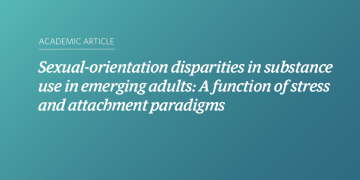
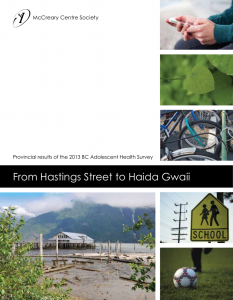
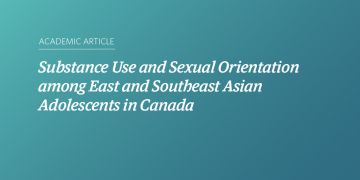
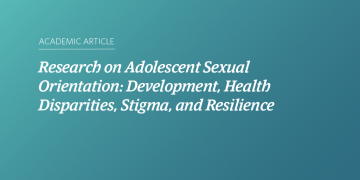

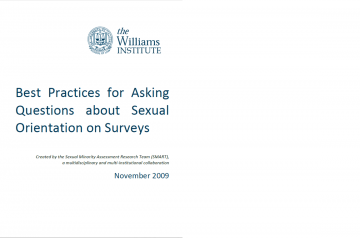
![Teal and blue gradient background with white text that says “Reducing problem substance use in Asian sexual minority and heterosexual youth [abstract]”](https://www.saravyc.ubc.ca/files/2009/08/Reducing-problem-substance-use-in-Asian-sexual-minority-and-heterosexual-youth-abstract_Twitter-360x180.png)
